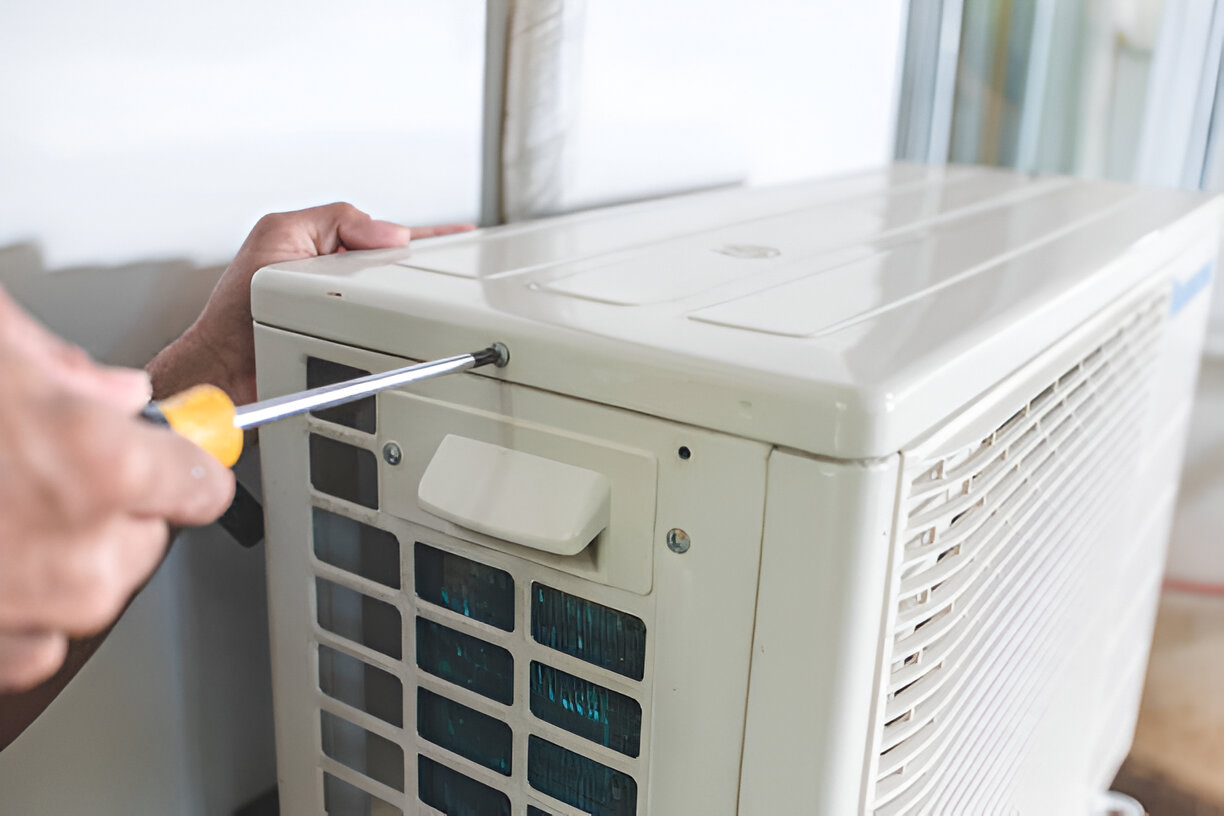Why replace your heat pump now?
- Older systems lose efficiency and break down more often. In Santan Valley’s high cooling demand, that adds up to higher utility bills and more emergency calls.
- Newer heat pumps deliver better cooling performance, more precise temperature control, and improved humidity management during monsoon season.
- Modern units are quieter, use more environmentally friendly refrigerants, and often qualify for local utility rebates, state incentives, or financing programs.

Common heat pump problems in Santan Valley
- Frequent short cycling or uneven cooling across rooms
- Rising electric bills even when settings are unchanged
- Old refrigerant types or leaks requiring recovery and repair
- Outdoor unit damage from dust, debris, or extreme summer temperatures
- Incompatible or failing thermostats and controls
- Worn compressors or motors that lead to noisy operation and poor efficiency
Assessment and evaluation
A thorough replacement starts with a professional evaluation of your existing equipment and home. Key steps include:
- Visual inspection of outdoor and indoor units, ductwork, wiring, and thermostat
- Refrigerant leak check and verification of current refrigerant type
- Airflow and duct leakage testing to determine whether ducts are limiting performance
- Review of electrical service and disconnect capacity
- Conversation about comfort goals, budget, and desired efficiency
Technicians will use a heat load calculation (Manual J) to right-size the new system based on your home’s square footage, insulation, window types, orientation, and occupancy. Right-sizing avoids the two biggest replacement mistakes: over-sizing (short cycling and humidity issues) and under-sizing (inadequate cooling).
Choosing the right replacement unit
In Santan Valley, cooling capacity and efficiency are the primary concerns. Recommendations typically consider:
- Energy ratings: SEER (cooling efficiency) and HSPF or COP for heating performance. Higher ratings mean lower energy use.
- Variable-speed and inverter-driven compressors for better comfort and lower run-time
- Proper refrigerant type that meets current regulations and reduces environmental impact
- Matched system components (indoor coil and outdoor condenser) to ensure warranty coverage and optimal performance
- Ducted vs ductless options depending on existing ductwork and remodeling plans
Local factors like extreme summer temperatures, dust exposure, and the amount of attic insulation will influence the preferred equipment and protective measures.
Permitting, code compliance, and refrigerant handling
Heat pump replacement requires permits in many jurisdictions around Santan Valley. A professional installer will:
- Pull the necessary permits and schedule any required inspections
- Ensure installations comply with local building codes and manufacturer guidelines
- Recover and dispose of existing refrigerant in compliance with federal and state rules, handled only by EPA-certified technicians
- Provide documentation required for rebates or warranties
Removal and disposal of old equipment
Proper removal includes safe refrigerant recovery, recycling metal and plastics when possible, and hauling away the old unit. Disposal follows environmental regulations to avoid fines and ensure responsible handling of refrigerants and hazardous components.
Typical installation timeline
- Initial evaluation and quote: same-day or within a few days
- Equipment selection and permit application: 1 to 14 days depending on permits and equipment availability
- Installation day(s): most straight replacements are completed in 1 to 2 days; complex jobs (ductwork modifications, electrical upgrades, or multi-zone systems) take longer
- Final inspection and system startup: performed at completion; documentation provided for warranties and rebates
Rebate and financing options
Homeowners in Santan Valley may be eligible for local utility rebates, state incentives, or federal credits for energy-efficient upgrades. Many manufacturers and contractors offer financing plans to spread the cost of replacement. When evaluating offers, compare:
- Which rebates require pre-approval or specific equipment models
- Whether rebates affect warranty registration or installation requirements
- Financing terms, interest rates, and any deferred payment conditions
Warranty coverage and long-term protection
Replacement systems typically include:
- Manufacturer limited parts warranty (often several years)
- Compressor warranties that may extend longer than other components
- Installation labor warranties provided by the installer (common to see shorter labor coverage than parts)Registering your equipment promptly and keeping maintenance records helps preserve warranty rights.
Expected efficiency gains and cost savings
Replacing an old heat pump can reduce cooling and heating energy use substantially:
- Replacing a 10-15 year old unit with a modern high-efficiency model can lower energy use by 15% to 40%, depending on initial equipment condition and proper sizing
- Improved efficiency reduces monthly utility bills during long Santan Valley summers and prolongs equipment life
- Reduced repair frequency means fewer unplanned expenses and less downtime during peak heat periods
Real-world savings depend on local electricity rates, home insulation, thermostat settings, and how often the system runs.
What to expect after replacement
- More consistent temperatures and improved humidity control
- Quieter operation with fewer on-off cycles if you choose a variable-speed model
- Clear documentation for warranty, permits, and any incentive claims
- Recommendations for a maintenance plan to preserve efficiency
Maintenance tips to protect your investment
- Schedule annual tune-ups, ideally before summer’s peak
- Change or clean air filters every 1 to 3 months depending on usage and indoor air quality
- Keep at least 2 feet of clearance around the outdoor unit; remove debris after dust storms or storms
- Monitor thermostat settings and consider a programmable or smart thermostat for better control
- Promptly address minor issues to avoid major failures during high-demand months
Replacing a heat pump in Santan Valley is a technical decision with clear comfort and cost benefits when done right. A professional evaluation, proper right-sizing, attention to local climate impacts, and adherence to permitting and refrigerant regulations ensure your new system performs efficiently and reliably for years to come.






